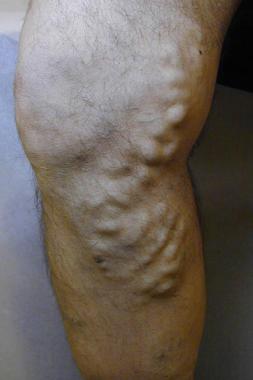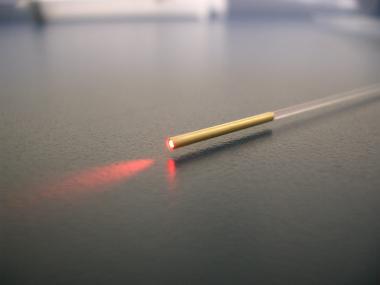I.Overview
Chronic venous disorders (CVDs) of the lower extremity are common problems caused by venous hypertension, which is commonly the result of reflux in one or more of the saphenous veins and their primary tributaries.
Chronic venous disorders (CVDs) of the lower extremity are common problems caused by venous hypertension, which is commonly the result of reflux in one or more of the saphenous veins and their primary tributaries.
Treatment options in patients with saphenous vein incompetence include conservative management or elimination of these incompetent pathways using endovenous techniques or surgery. The image below depicts varicose vein before treatment with endovenous laser therapy.

See Superficial Venous Insufficiency: Varicose Veins and Venous Ulcers, a Critical Images slideshow, to help identify the common risk factors and features of this condition and its management options.
Although conservative management with compression therapy may improve the symptoms of chronic venous insufficiency, it does not cure it. Historically, surgery was considered the best way to eliminate incompetence using ligation of the saphenous vein at its deep vein junction and removal of the abnormal saphenous vein segments; this procedure is known as high ligation and stripping (HL/S). Over the last 10-15 years, HL/S has been essentially replaced by percutaneous endovenous thermal ablation. Two types of thermal ablation procedures exist: endovenous laser ablation (ELA) and radiofrequency ablation (RFA). Both procedures are associated with high success and low complication rates. The procedures are generally performed on an ambulatory basis with local anesthetic and typically require no sedation. The patients are fully ambulatory following treatment, and the recovery time is short. In this article, ELA is reviewed in detail.
II. ELA mechanism of action
The underlying goal for all thermal ablation procedures is to deliver sufficient thermal energy to the wall of an incompetent vein segment to produce irreversible occlusion, fibrosis, and ultimately disappearance of the vein. The mechanism of vein wall injury after ELA is controversial. It has been postulated to be mediated both by direct effect and indirectly via laser-induced steam generated by the heating of small amounts of blood within the vein.[1] Adequately damaging the vein wall with thermal energy is imperative to obtain effective ablation. Some heating may occur by direct absorption of photon energy (radiation) by the vein wall, as well as by convection from steam bubbles and conduction from heated blood. However, these later mechanisms are unlikely to account for most of the impact on the vein.
Diode lasers are most commonly used for ELA. Laser generators exist with multiple different wavelengths, including lower wavelengths that are considered hemoglobin specific and include 810 nm, 940 nm, 980 nm, and 1064 nm. Higher wavelengths are considered water specific and include 1320 nm and 1470 nm. Although it is still not definitively established in the literature, some authors suggest that the higher wavelength lasers produce similar efficacy at lower power settings with less postprocedure symptoms.[2]
It can be performed with multiple different laser fiber designs (ie, bare-tip fibers, jacket-tip fibers [see image below], radial fibers) and diameters available from a variety of vendors. Each of the fiber designs has been demonstrated to be effective in closing the saphenous vein. At this point, there are no conclusive data demonstrating a superiority of a given fiber, wavelength and energy deposition combination, efficacy, significant adverse effects, or complications as metrics for comparison.

III. Target veins
ELA has been successfully and safely used to ablate the great and small saphenous veins, the anterior and posterior accessory great saphenous vein, the superficial accessory saphenous vein, the anterior and posterior circumflex veins of the thigh as well as the thigh extension of the small saphenous vein, including the vein of Giacomini.
ELA has been used to treat long straight competent tributary veins outside the superficial fascia, particularly in patients who are obese and who either sclerotherapy or microphlebectomy would be difficult, time consuming, or prone to side effects.
Source emedicine.com
DUC TIN SUGICAL CLINIC
Tin tức liên quan

Performance diagnostique de l’interféron gamma dans l’identification de l’origine tuberculeuse des pleurésies exsudatives

A Mixed Phenotype of Airway Wall Thickening and Emphysema Is Associated with Dyspnea and Hospitalization for Chronic Obstructive Pulmonary Disease.

Radiological Approach to Asthma and COPD-The Role of Computed Tomography.

Significant annual cost savings found with UrgoStart in UK and Germany

Thrombolex announces 510(k) clearance of Bashir catheter systems for thromboembolic disorders
Phone: (028) 3981 2678
Mobile: 0903 839 878 - 0909 384 389







